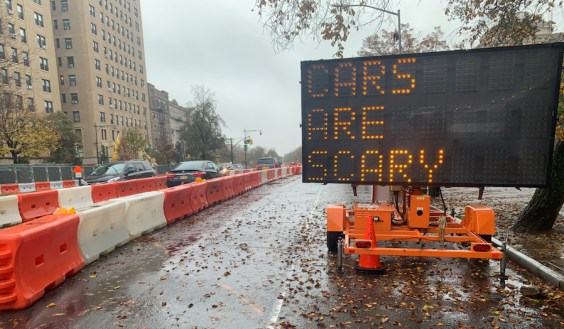Last week, Streetsblog sat down with California Assemblymember Richard Bloom, who represents Santa Monica and other West Los Angeles communities. We asked him to talk about the state budget, the cap-and-trade expenditure plan, and funding for transit and housing. Bloom chairs the Subcommittee for Transportation for the California Assembly Budget Committee.

Bloom talked about the process for crafting the cap-and-trade compromise, the impacts the new money will have on transportation, the need for more transportation funding, and some local transportation and development issues in his district.
The California state budget was passed by both legislative houses just before its June 15 deadline, and the governor signed it at the end of that week.
Streetsblog: Are you more or less pleased with the final budget and the cap-and-trade expenditure plan?
Bloom: I'm very pleased.
California is still in recovery mode. The most notable thing about the budget is that we're beginning to provide funds for many of the programs that have been cut over the past years, since 2006 or so, and we're also beginning to fund new programs.
The most exciting of these, I think, is early childhood education. We're only chipping off a bit of that, but it's a beginning, and it shows a way into the future.
Streetsblog: What about the cap-and-trade expenditure plan?
Bloom: There were three different proposals, one from the Senate, one from the Assembly, and one out of the governor's office, on how we would utilize the cap-and-trade money. What ultimately happened was somewhat of a blending of the three ideas--tilted towards the governor's proposal, which I think we all kind of expected. The good news is we've got a good solid beginning.
There's a specific allocation for this year, and then in ensuing years, it's based on percentages. The reason for that is we're not sure how much money there's going to be, as fuels are coming under the cap and that is going to change the dynamic. So everybody felt that it was important to not finalize the allocations going forward.
The good news for everybody is that as things move forward, we think the auctions are going to continue to be successful, and that there's going to be a rising amount of available money. That means we're not just looking at one-year, two-year, or three-year scenarios. This is going to go forward for many years, and this can become an ongoing source of money.
And, as it's going to do for high-speed rail, it can provide an ongoing source of revenue for specific types of projects.
And that's never existed in California before. Given the uncertainty we have in Washington DC,
having some stability and some new funding takes on more importance.
This is a very exciting time for transit advocates.
Streetsblog: Because the cap-and-trade plan includes money for transit operations, which has no other dedicated source of state funding.
Bloom: As I observed during the cap-and-trade discussions on the conference committee, this is the most significant pot of new money that the state has to spend. It's a big deal.
And it all has to relate to our A.B. 32 carbon reduction goals--to make sure that, to the extent possible, we're able to gain the highest possible emissions reductions. Transit performs really high on that measure. I think it's appropriate that there is money in there for transit.
The specifics are not worked out yet, but the Air Resources Board is probably going to be responsible for allocating most of this money. We still have to go through an allocation process, and that will take into consideration the various metrics that are applicable to each program.
Even though it's a lot of money, and it's new money, still not the kind of money that's going to satisfy every need out there. So there's still going to have to be some way of winnowing things down.
Streetsblog: The loss of redevelopment funds has hit some areas hard. You currently have a bill (A.B. 2493) that would free up bond money that cities are paying interest on but cannot access for projects planned by their redevelopment agencies.
Bloom: There have been various proposals to find a mechanism for replacing redevelopment, and so far we haven't seen that come to fruition.
Right now there is approximately $750 to $800 million in bonded indebtedness that local governments are not able to access under the changeover in redevelopment. This is money for projects that would be very helpful on a number of different fronts. We think the bill's on track to be passed, but it's a little bit uncertain. Santa Monica would benefit if it passes and is signed by the governor. We've been working with the governor's office, and we think the governor would likely sign it if it gets passed.
Streetsblog: There has been no dedicated state funding for housing, and now the cap-and-trade plan has an allocation for affordable housing. Could that be a cushion for the loss of redevelopment?
Bloom: Certainly it would provide some funding for affordable housing that's missing now because of the absence of redevelopment. The good news for transit advocates is that, in order for new housing to perform highly on the carbon reduction scale—and to qualify for cap-and-trade funds—it needs to be part of transit oriented development. So it will be near transit.
I think that's helpful because it will work symbiotically with other pots of money. There is an impetus for combining the money for rail with affordable housing money to build up within a systems approach. At least in theory you wouldn't allocate money for housing, for example, unless you knew a project was going to be built near a transit stop.
My best experience is in Santa Monica, where there's a lot of tension over transit oriented development now, and the disconnect between the light rail project and some of the housing and mixed-use projects that have been proposed along the way are really problematic.
Santa Monica, as you know, has done a good deal of planning around transit issues and traffic reduction strategies, and yet some of the things that we've planned are meeting with resistance. I think that's an unfortunate development, but the more we tie funds to the kinds of planning Santa Monica has done, the better job we're going to do in getting people to use transit and in lowering our carbon footprint.
Unfortunately there's always been a significant amount of resistance to development, even when it's responsible development. That's just something we have to deal with.
My interest is looking more closely at subregional needs. In Los Angeles, because the transit system has been broken for so long, we necessarily focused on large-scale regional projects like the subway and various light rail projects, and we spent very little time looking at subregional projects.
There are numerous communities that have problems connecting with one another. We are missing that subregional piece completely.
An example: the subway is going to stop in Westwood, but many of the congestion problems we have are west of there. So what do you do to move people around once they get to Westwood? I think we should be looking at something like a trolley system--streetcars--that start in Westwood, come out to Santa Monica, perhaps on Wilshire Blvd, maybe come back on Pico...
Streetsblog: Didn't they used to have that?
Bloom: Yes, it would look something like the Redcar system. Other than buses, and now bicycling, that local piece has largely been missing. So we have a lot of work to do there. It could be funded using different funding sources, but I think that we need to start doing some of the planning now.
Streetsblog: Santa Monica would be a good place to do that, with its high density, its traffic congestion....
Bloom: But I think it would be easy to quickly identify other areas. For example, the corridor from the Robertson Expo stop, up Robertson Blvd, across Pico--all the way from Robertson to the Cedar Sinai area—is highly, highly congested. I think the area could benefit tremendously from a streetcar line.
Just imagine connecting Beverly Hills, Cedar Sinai, West Hollywood, and Hollywood with a streetcar line. There's an enormous amount of traffic congestion there, and a public that would be very warm to the idea.
The interesting thing about streetcar lines is they can be financed using local increment money, you can form districts that can pool together their money to finance the capital and operational costs for these projects.
Streetsblog: So it's a question of getting the different jurisdictions to work together....
Bloom: Yes. We don't get around to that conversation in Los Angeles because—this is not a criticism, but most of our transit planning is done at Metro, or SCAG is thinking about it, but we never get down to the finer level, where things are happening in our communities. And yet that is where the greatest push-back comes, from residents who are tired of not being able to get around.
We need to be looking at that those alternatives; we haven't really had the opportunity to do that.
Streetsblog: What about the Big Blue Bus?
Bloom: It's great. And it will continue to exist, but it's only one piece of the puzzle.





